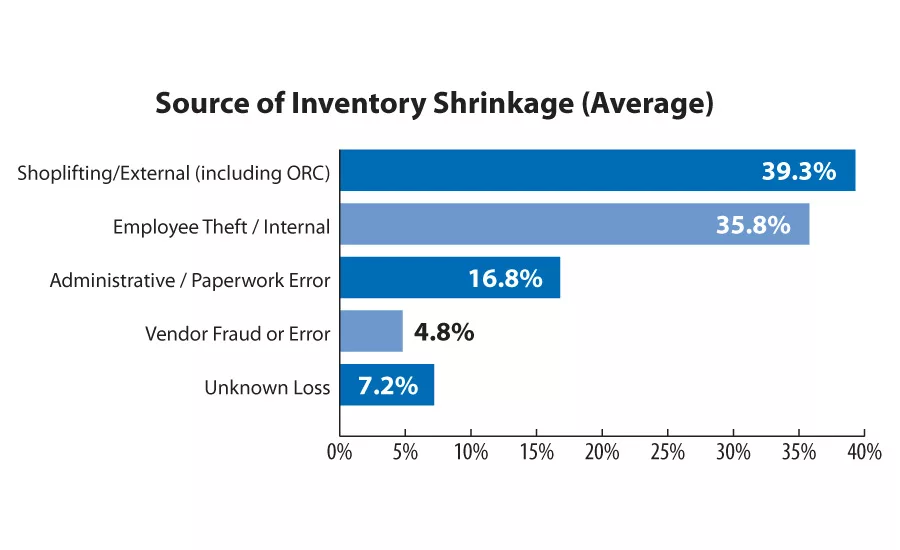Preventing Loss and Preserving the Customer Experience
Retail loss prevention faces numerous challenges in a changing and dynamic retail environment.


Inventory shrinkage is principally attributed to external shoplifting, which includes organized retail crime and employee theft. Together, these sources constitute the great majority of inventory loss and shrinkage. Data courtesy of the National Retail Federation’s 2015 National Security Survey

Alarms, video recorders and live security video continue to be the largest prevention systems in use and are quite effective in combatting retail loss.
Data courtesy of the National Retail Federation’s 2015 National Security Survey

Approximately half of the losses per theft and robbery incidents ranged from between $200 and $2,000. Data courtesy of the National Retail Federation’s 2015 National Security Survey

“Initiatives to combat ORC syndicates include a dedicated team of investigators that uses analytics and data to study trends and methods used on the ORC market,” says Ron Friedman, who is is co-Leader of the firm’s National Retail & Consumer Products Industry group. Photo courtesy of Ron Friedman

Shane Berry, Group Vice President, Asset Protection, for retailer Abercrombie & Fitch, says there are many concerns with retail loss prevention from his perspective, but one notable sources of loss is organized retail crime (ORC). Photo courtesy of Shane Berry
Several years ago, an organized shoplifting ring near Buffalo, New York, stole millions of dollars in merchandise from big box stores such as Walmart, Sears, Home Depot, JoAnn Fabrics, Tops and Wegmans. The merchandise was sold to another criminal for 25¢ on the dollar. That criminal then sold the merchandise on eBay for about half of its retail value, primarily to out-of-state customers.
The ring continued – until the FBI found them. The FBI eventually convicted all of the participants and sent them to prison.
Retail theft is a billion-dollar enterprise riding a steady upward trend. It requires adoption of all available tools and technologies and an intimate understanding of the weaknesses and vulnerabilities within the supply and sales channels of its operation.
$45 Billion In Loss and Growing
Jack L. Hayes International is a loss prevention security consulting firm specializing in asset protection and safety. They are finding that retail loss is on the rise. The firm recently released its 28th Annual Retail Theft Survey that showed a steady rise in retail theft loss over the past decade.
According to the findings, more than 1.2 million shoplifters and dishonest employees were apprehended in 2015 by just 25 large retailers who recovered more than $200 million from these thieves.
“Retail theft, by both shoplifters and employees, continues to plague the retail industry. Our latest Annual Retail Theft Survey reflects an increase in shoplifter and dishonest employee apprehensions, 2.0 percent and 1.0 percent respectively, in 2015. Overall recoveries from those apprehensions totaled more than $200 million and were up 1.2 percent,” says Mark R. Doyle, President of Jack L. Hayes International. “It should be noted that the apprehension of shoplifters and dishonest employees has increased in nine of the last 10 years.”
These trends must be viewed in light of how much this costs retailers. According to the National Retail Federation’s 2015 National Security Survey, shrinkage from retail loss amounted to a whopping $45.2 billion in 2015. Understanding how this happens means examining those who are responsible for it.
The Rise of Organized Retail Crime
Shane Berry, Group Vice President, Asset Protection, for retailer Abercrombie & Fitch, says there are many concerns with retail loss prevention from his perspective, but one notable sources of loss is organized retail crime (ORC).
Berry and many others like him are battling a very well-planned contingent of thieves who work retail channels to steal and confiscate merchandise. They know the where and how of invading a retail establishment and making off with stolen goods and distributing them to points where the goods can just vanish. They even know the state laws and statutes and work around any weaknesses that interstate robbery allows.
Ron Friedman is with the Los Angeles, California-based Marcum LLP, a tax and management-consulting firm. Friedman is co-Leader of the firm’s National Retail & Consumer Products Industry group. He provides consulting services for closely held and emerging businesses in the apparel, manufacturing, distribution and retail industries.
“Initiatives to combat ORC syndicates include a dedicated team of investigators that uses analytics and data to study trends and methods used on the ORC market,” says Friedman. “The team sifts through data from all aspects of the company using link analysis and other analytics tools to build interconnections and find trends and patterns to identify ORC syndicates and the specific individuals involved. This has helped keep ORC gangs out of stores, even shutting down some gangs and facilitating arrests in certain cases.”
Bob Moraca is the Vice President of Loss Prevention for the National Retail Federation (NRF) in Washington. He also sees ORC as a serious and emergent threat to retailers. “Organized retail crime is one of the things that keep retail executives up at night,” says Moraca. “It’s a $30 billion per year issue in losses that gets passed on to consumers.”
Organized crime includes shoplifting from external sources. According to NRF’s data, this source of loss has surpassed employee theft for the second year in a row and appears to be a concerning trend.
“Industry collaboration and law enforcement liaison are critical in eradicating these professional groups who are responsible for the highest percentage of our external loss,” says Berry. “We are challenged daily by their national mobility, sophisticated schemes and persistence.”
Moraca of the NRF explains that organized retail crime associations and partnerships with local law enforcement officials where a specific retailer resides is key to prevention. He says that 33 states have organized retail crime partnerships on the books, and it is most effective for retailers and law enforcement in combatting this growing concern in retail loss.
In New York State, a bill was recently signed into law aimed to curtail organized crime. The bill was a longstanding effort by retailers, law enforcement and political leaders.
“It’s not personal-use shoplifting,” says Ted Potrikus, President and CEO of the Retail Council of New York State. “These are professional thieves who go into stores to steal diabetic test strips, razor blades, designer clothing, jewelry, power tools – anything that’s in demand on the black market that they can re-sell. Organized theft gang leaders victimize consumers and retailers – but also know that they can abuse drug addicts who are looking for ways to earn a quick $20 to put toward their habit. They’ll pay the man on the street pennies on the dollar for everything he steals for them.”
The New York State law is quite comprehensive and addresses the legal jurisdictions in prosecuting such crimes. Criminals have been aware that once merchandise is stolen, they move across state lines, making it more difficult to get caught.
New York State is following in suit of many other states who are passing laws targeted at organized retail crime, including Massachusetts, Michigan, North Carolina and Pennsylvania.
Recovering Loss
Shoplifters, however, may be pursued and convicted. Merchandise and stolen property can be recovered – and it is.
According to Hayes International’s survey data findings, 1,246,003 shoplifters and dishonest employees were apprehended in 2015. This was up 2.0 percent from 2014. And more than $200 million was recovered from apprehended shoplifters and dishonest employees in 2015 – up 1.2 percent from 2014.
Achieving recovery of loss requires technology and tools to get the job done. Tools include cameras, video, digital tracking and tracing, and constant and careful monitoring.
Moraca says that security video combined with analytics are greatly improved and becoming very effective in catching thieves – both internal ones and external ones.
“CCTV systems and video analytics have been enhanced from a retail perspective,” says Moraca. “They can count items on a counter. They have the ability to red flag anomalies. These analytics are getting better and better all the time. They have almost 360-degrees of camera coverage, and the view can be manipulated with more pixels to cover more ground.”
The biggest trends in loss prevention revolve around the push in today’s retail environment to provide customers with a touch-and-feel shopping experience, says Darren McCue, President of Dunbar Security Solutions, who adds that stores like Apple are arranged in an open, mobile manner that allows shoppers to fully explore products before purchasing them. The checkout process at these establishments is also open and mobile, with store associates being able to complete customer purchases via handheld devices standing anywhere in the location.
McCue adds that these types of setups are accompanied with a specific set of loss prevention challenges, retailers are using technology, risk management and data maintenance tools to solve them.
Surveillance and intrusion detection systems allow retailers to keep track of customers and employees throughout their stores, mitigating the risk of theft, he says. With people walking in and out of open stores throughout the day, cameras give retailers the power to identify criminals and would-be thieves in action.
Surveillance technology provides much more impetus when combined with today’s digital technology. Most retail experiences are somewhat, if not entirely digital, meaning payment is often made through traceable systems and accounts. When embraced and understood, they may greatly aid in recovery of loss merchandise and conviction of the thieves and rings behind them.
Your Supply and Sales Channels
Mitigating risk and preventing loss prevention begins by knowing and understanding the multiple channels within the supply chain as well as the flow of retail processes that are involved in the establishment. Knowing this helps understand where weaknesses exist. Such weaknesses and vulnerabilities are fertile chinks for theft, pilferage and loss to occur.
McCue emphasizes the fact that retailers’ technology usage goes hand-in-hand with their growing need for a total risk management strategy. A complete strategy extends beyond loss prevention or shrink and involves a combination of physical and digital measures that track assets and inventory, protect data infrastructure, and analyze and predict shoplifting behavior, he adds.
In addition to cash and the physical handling of currency, retailers must be vigilant of where, within their supply and sales channels to know where to dedicate resources to prevent loss.
“Speaking to the continued proliferation of channels to drive product visibility, the ability to understand what product came from what channel – when it enters the stream of commerce, if it legitimately entered the stream of commerce, and being able to understand the life cycle of all product, cradle to grave, is the ultimate goal,” says Berry. “There are different ways to accomplish this goal, but we have to more easily and substantively be able to show the return on that investment when those dollars can be used for other needs in the business. We are focused on predictive and prescriptive analytics to reduce the scope and scale of loss.”
Knowing where to dedicate resources is largely a function of leadership professionals. According to McCue, leadership must facilitate and practice a proper risk management culture from the top down to ensure businesses succeed against retail loss. Retailers must invest in technology and take advantage of the power of data to most effectively discover and stop threats.
Enterprise security executives who seek to develop tools and techniques to combat retail loss and instill adequate protection against it must thoroughly analyze their own distribution and sales channels and be aware of the dynamics of their retail process.
“The focus has to remain on the customer,” says Berry. “Any program you implement – any technique you employ – must be as invisible and unobtrusive as possible. We have to prevent loss while preserving the customer experience.”
Using Verified Alarms for Continuity and Efficiency at Panda Restaurants
By Claire Meyer, Managing Editor
There was an abundance of alarm notifications and police dispatches for false alarms that lead to significant false alarm charges – plus slower response times – for Panda Restaurant Group, Inc., which encompasses the fast-casual dining establishments of Panda Express, Hibachi-San and the fine dining of Panda Inn. In 2007, the 900-plus restaurants were racking up close to $450,000 each year in false alarm fines, and store managers were being called in the middle of the night to respond to these false alarms, often immediately sending the police to err on the side of caution.
When Lyle Forcum, CPP, PCI, joined the Group in 2008 as its Executive Director of Asset Protection, this was one of the first challenges he chose to tackle.
Working with Interface’s video-verified alarm system, the number of false alarms dropped to less than one-fifth of the 2007 level within three years. Police response time decreased from 30 minutes to just over five. The number of incidents, too, has decreased, as the system was used to verify the alarm codes used to enter the stores, detecting and preventing the use of shared or compromised codes.
The system integrates both alarm and video into one solution, anchored by a traditional alarm panel and an NVR. Interface automatically receives live video simultaneously with any alarm signal generated at a Panda location, and each alarm is verified with live video at the Interface Central Command Center. An additional “voice down” feature can be added, utilizing strategically placed speakers and microphones throughout the location to enable Interface security professionals to interact directly with the restaurant.
According to Forcum, this “voice down” feature is best utilized in high-crime areas to talk directly to aggressive or potential criminals in the restaurant, giving them direction while deflecting any anger from all Panda associates present. In order to create this win-win, four times a day at times of the General Manager’s choosing, a security professional from Interface checks in with the store via a live voice down two-way communication, providing a deterrent to potential criminals as well as an additional layer of security and protection for all the guests and store associates.
In addition to providing this added layer of security, the Interface Command Center professionals monitor and help to perpetuate the Panda Restaurant Group’s intention of creating a safe and empowering environment where people are inspired to better their lives. Interface account representatives have gone through Panda’s Great Operations training, immersing themselves in the Panda culture. Forcum has also worked with these representatives to develop appropriate and respectful language and responses to different situations. For example, if people choose to congregate within the outside dining area of a Panda Express after hours, the duress alarm would be locally triggered by Panda Associates, and an Interface security professional will identify and communicate with the disruptive people, respectfully requesting they depart the restaurant.
This interactive video and audio system sets a high security standard among all Panda Restaurants; all store managers know exactly how to control the interactive system and can now transfer between 1,900-plus Panda Restaurant locations and not have to learn a new security program or equipment. To take it a step further, Forcum has tied this video system into a point-of-sale exception-based reporting system that immediately detects any cashiers exceeding strict parameters of deletes, voids, refunds, etc. during his or her shift. Within 24 hours, the GM is accountable to review the suspicious transaction(s) with video attached to immediately detect and defeat internal fraud.
Looking for a reprint of this article?
From high-res PDFs to custom plaques, order your copy today!



